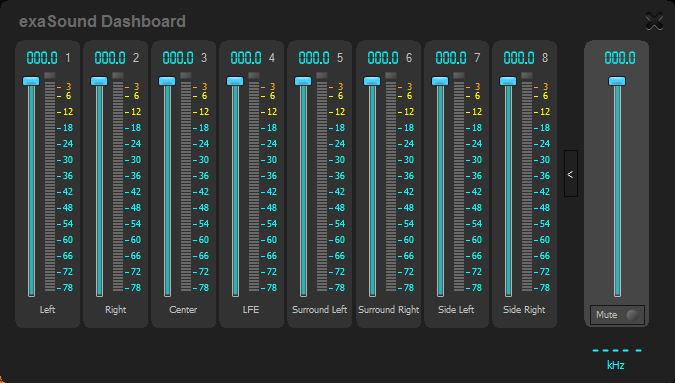OverviewAs a result of
this thread, I contacted several manufacturers of nice audio hardware.
George Klissarov, the owner of exaSound, was one of the first to reply. He sent me an e18 demo unit right away. Then he worked with me on several e18 + JRiver issues, helping improve the experience for both of our users.
The e18 is an audiophile 8 channel DAC. It competes primarily with other expensive audiophile DACs. More information here:
http://www.exasound.com/e18DAC/Overview.aspx The e18 particularly excites me because most audiophile gear is 2 channel only. George went so far as to say he's had a tough time getting reviewers to look at the 8-channel e18 (even in two channel mode) because they focus on 2-channel DACs only.
This is totally lost on me. If you ever watch a movie, you need more than two channels. If you want a subwoofer, you should have more than two channels. If you ever bi-amp or tri-amp, you need more than two channels. If you have SACD or other HD audio, it often uses more than two channels. And even if you don't need extra channels, they future proof your purchase.
Good StuffFlawless driver designThe e18 has the best driver I have encountered. I believe less-is-more from audio drivers. I want the driver to be reliable, bit-transparent, and otherwise get out of my way. If you've ever configured a Creative card to be bit-transparent and get channel routing right, you'll understand why this is important (it's a nightmare to configure the Creative, and many other cards, in my opinion).
Here's how the e18 driver panel looks:
 In house driver development
In house driver developmentLike I said above, the drivers are great. And they're written in house by exaSound. I like in-house design, because often when I talk to hardware makers about issues, they have no real ability to debug or fix their driver issues since they bought a driver package from some third-party.
No noise on boot / sleepIt's stone silent when the computer's power state changes. Since the unit is powered externally, this makes sense. It's still important, as a lot of good studio-quality hardware knocks you out of the room on power changes if you have your amplifiers on.
Ultra low line noisePlaying silence at full volume with my ear right next to a big speaker is as quiet as anything I have ever tested. Other consumer-level cards like Creative and Asus have also mostly figured this one out, but the e18 may be somewhat better.
Impressive specsThe specifications for jitter, distortion, etc. are basically perfect:
http://www.exasound.com/e18DAC/Specifications.aspx External / USB designI like the idea of putting the DAC as far away from other powerful things (like the amplifier or computer) as possible. The stand-alone USB design of this unit makes that possible.
ReliableI used the e18 in my home theater for about a month. I never had a drop-out or other hardware glitch.
Great soundSince I have analog connections that are slow to switch, there's really no way for me to properly A/B test the e18. The e18 sounds great to me.
Wish ListPriceThe retail price of the e18 is $1999. It's comparable to other limited production audiophile DACs, but out-of-reach of many normal people. I would love to see a scaled down unit coming in closer to the price of the high end consumer cards from Creative and Asus.
Volume not rememberedBy biggest problem using the DAC is that it comes on at -40dB as a safety check. Since I use Internal Volume in Media Center, this meant I had to do an extra step each time I sat down on the couch to get the e18's volume back to full level. George has promised a coming fix for this.
More power on the headphone outputThe headphone amplifier sounds great, but is only borderline powerful enough for power hungry headphones like Sennheisers. The listening volume was comfortable at full volume on HD 650's. But this means there isn't really any headroom if some processing (like Replay Gain) was reducing the volume.
Ability to overdrive outputsThe e18 outputs at the reference RCA voltage. This is a good default. As a power amplifier user, I'd like the ability to optionally get a little more voltage.
Turn on and off with USBSince it's a stand-alone external unit, you have to turn it on and off by hand. It would be neat if talking to the ASIO driver would turn it on and off automatically.
WDM driverThe hardware is ASIO only. There is not a WDM driver. This is a mixed bag. It means Windows won't ever accidentally play sounds to it, which is good. But it also means you need to use loopback (still experimental) in JRiver if you want to use the hardware for gaming, browser-based video playback (Netflix), or use it in other programs.
Configuration with JRiver Media CenterSince the driver is straight-forward, there isn't much to do.
Set the program to use ASIO in Options > Audio. I used these ASIO settings:

I prefer Internal Volume + Volume Protection. I leave the e18 at full hardware volume. This is done for improved signal headroom in our audio stack. More on that here:
http://wiki.jriver.com/index.php/Volume#Internal_Volume_Headroom ConclusionTo me, the e18 is basically a perfect hardware and driver combination.
Kudos and thanks to exaSound for what they've built and for giving me a chance to enjoy it.

 Author
Topic: exaSound e18 – High End 8 channel USB DAC – Review (Read 38075 times)
Author
Topic: exaSound e18 – High End 8 channel USB DAC – Review (Read 38075 times)

